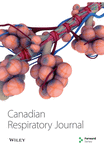The Addition of Salmeterol 50 µg Bid to Anticholinergenic Treatment in Patients with COPD: A Randomized Placebo Controlled Trial
Abstract
BACKGROUND: In the past, the role of long-acting beta2-agonists in chronic obstructive pulmonary disease (COPD) relative to other agents has been unclear.
OBJECTIVES: To compare the effect of adding salmeterol (50 µg bid) or placebo to concurrent anticholinergic therapy on symptom scores, quality of life, prebronchodilator lung function and exacerbations in patients with moderately severe COPD.
METHODS: This was a double-blind, randomized, parallel-group study in patients aged 40 years or older receiving anticholinergic medication. Patients were randomly assigned to treatment with placebo (n=207) or salmeterol (n=201) via a Diskus/Accuhaler inhaler for 24 weeks.
RESULTS: The morning trough (prestudy drug) forced expiratory volume in 1 s (FEV1) increased significantly above baseline levels among the salmeterol-treated patients. Improvement in FEV1 was greater in the salmeterol group than in the placebo group at four weeks (difference 0.06 L, P <0.005), eight weeks (0.06 L, P <0.005) and 16 weeks (0.05 L, P <0.05) after the start of treatment. There was a nonsignificant trend in favour of salmeterol after 24 weeks of treatment (P=0.198). Improvements in morning peak flow were significantly greater in the salmeterol group over 24 weeks (P <0.01). Although symptom scores were numerically higher in the salmeterol group than in the placebo group and there was less requirement for rescue bronchodilator use, these differences were not statistically significant. In the salmeterol group, fewer patients had exacerbations of COPD, and there was a trend toward an improved quality of life. The safety profile of the two groups was similar.
CONCLUSIONS: Salmeterol has a beneficial effect when added to existing anticholinergic therapy in patients with COPD. The regular use of salmeterol for six months was not associated with worsening of the underlying airflow obstruction; rather, there was a tendency for the trough FEV1 to improve above the baseline levels over the treatment period.




